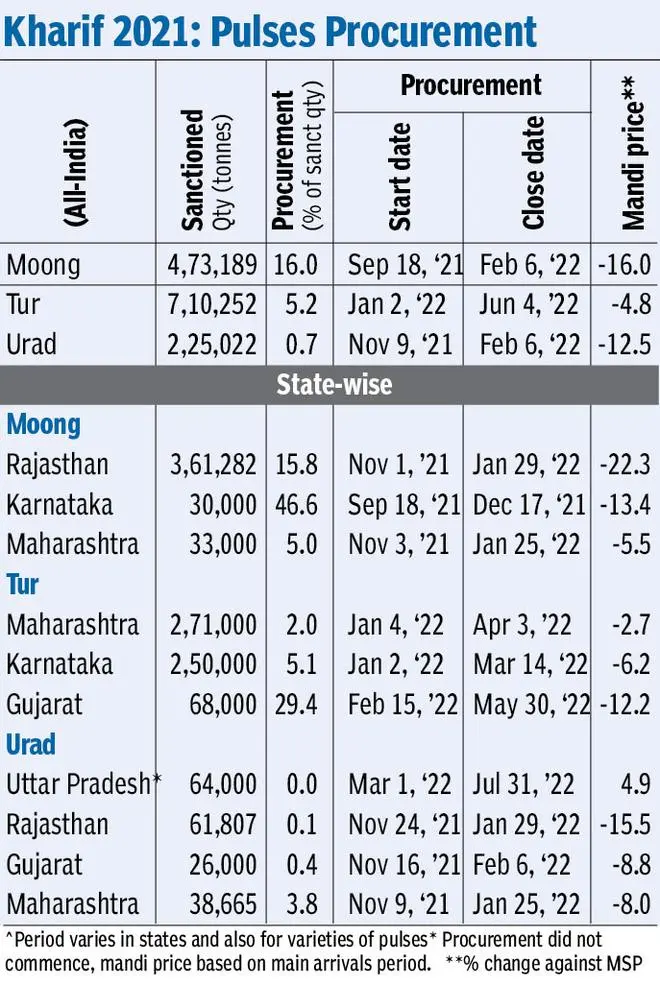The Centre’s plan to increase procurement of pulses may remain on “paper” unless it comes out with a clear policy on “procurement and disposal”, experts say.
Procurement of pulses has been lower historically with the purchase of urad (black matpe) being less than one per cent of the target. As a result, farmers are unlikely to get the minimum support prices (MSP) for pulses, they say.
Data collected by BusinessLine show that pulse procurement has generally been low. Last week, the Union Cabinet raised the procurement limit of tur (pigeon pea), urad and masur (luntil) to 40 per cent from 25 per cent of their total production.
Data show that only 0.7 per cent of the sanctioned 2.25 lakh tonnes (lt) of urad and 5.2 per cent of 7.1 lt of tur could be procured last year by the Centre through its agencies — Nafed (National Agricultural Cooperative Marketing Federation) and Food Corporation of India (FCI).
Moong’s purchase was slightly better with 16 per cent of 4.7 lt (sanctioned quantity) could be purchased. Data also show that mandi prices (all India average) were 5-16 per cent below MSPs during the procurement period.
Also read
Usually, the Centre points to higher mandi prices or States’ poor performance for the low procurement. However, data point to the lack of a political will to take any decision since higher mandi prices of pulses will also mean inflation. The retail inflation in pulses was 0.18 per cent in July from the year-ago period.
“As India is not self-sufficient in pulses, the government cannot keep a huge reserve creating an artificial shortage in the market. Whatever quantity is to be procured beyond buffer norms has also to be sold out somewhere and the open market auction is the only option left when pulses are neither demanded by States nor distributed under the National Food Security Act (NFSA),” said a former managing director of Nafed.

Procurement policy
The current policy allows the government to reimburse losses to a certain extent and not entirely when Nafed buys at MSP and sells at the market rate. The agency’s procurement policy also takes into consideration how much quantity it can buy, the former official said, adding there is no such limitations for wheat and rice. Increasing the procurement limit “on paper” will have no meaning unless target is also met, particularly when farmers sell below MSPs in mandis, he added.
According to the Agmarknet portal, moong prices in top producer, Rajasthan, were 22.3 per cent below MSP of ₹7,275/quintal during November-January of 2021-22 when the government procured the pulse crop in the State.
However, it could procure only 57,260 tonnes though the sanctioned quantity was 3.61 lt. From Karnataka, the government purchased 13,980 tonnes out of 30,000 tonnes sanctioned, 46.6 per cent of the target, the highest for any crop among all States.
Uttar Pradesh was the only State where urad in mandis was sold above MSP between March and July this year, the main arrival period. There was no procurement of the crop despite 63,000 tonnes approved.
Criticising the Centre’s move not to include moong and chana in the higher limit of 40 per cent, Kisan Mahapanchayat’s president Rampal Jat said since masur has been included in the decision which shows that the move is also for rabi-grown pulses, there should be no restriction of quantitative limit on procurement of pulses and oilseeds as done in paddy and wheat.







Comments
Comments have to be in English, and in full sentences. They cannot be abusive or personal. Please abide by our community guidelines for posting your comments.
We have migrated to a new commenting platform. If you are already a registered user of TheHindu Businessline and logged in, you may continue to engage with our articles. If you do not have an account please register and login to post comments. Users can access their older comments by logging into their accounts on Vuukle.